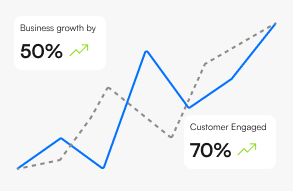What Are Vertical AI Agents? Future Beyond SaaS and Teams

Preetam Das
October 16, 2025
9 min

Table of Contents
For years, businesses scaled by stacking SaaS tools and hiring bigger teams. That model is breaking. The next evolution isn’t more software, it’s software that thinks and acts on your behalf. Vertical AI agents are that leap.
General-purpose AI models like ChatGPT or Gemini are the “jack of all trades.” AI agents mark the next step in automation, moving beyond generative AI, rule-based chatbots, and large language models (LLMs).
Vertical AI agents are the specialists, built for specific industries, connected to real systems, and capable of executing end-to-end workflows with accuracy and context.
What is a Vertical AI Agent
A vertical AI agent is a domain-specific system designed to operate autonomously within a defined industry.
It’s fine-tuned on proprietary datasets, regulatory frameworks, and workflows unique to that sector, allowing it to execute tasks, enforce compliance, and scale reliably inside existing business systems.
Five core attributes define a vertical AI agent:
- Task-focused, optimized for defined, repeatable workflows within a domain.
- System-integrated interfaces directly with enterprise APIs, CRMs, ERPs, and databases.
- Autonomous plans, executes, and self-corrects with minimal human input.
- Domain-trained fine-tuned on sector-specific data, standards, and compliance rules.
- Context-persistent retains short- and long-term memory for accurate, continuous operation.
How System Design Powers Vertical AI Agents
The strength of a vertical AI agent lies in its system architecture, how reasoning, memory, and action layers work together to deliver domain-specific intelligence at scale.
Without this architecture, a vertical agent would behave like an AI chatbot, reactive, one-shot, and context-blind.

In the image above, we can see that each layer of a vertical AI agent is engineered to plug gaps left by siloed SaaS apps and static business logic. The layers form a feedback loop: data is captured, compliance is enforced, actions are planned, and tools are triggered—all in sync.
Memory preserves what agents learn, orchestration governs how and when tasks are run, and the cognitive layer ensures rules and safety are never skipped. The apex model layer then interprets each new challenge using all of this context, executing reliably at enterprise scale.
What makes this design unique is interaction: actions taken in the tool layer reshape the agent’s memory and influence future decisions, while context from earlier tasks helps guide new ones.
These feedback cycles mean every vertical agent gets smarter and safer with use, learning from successes and exceptions in real-life business conditions.
That’s how vertical AI agents deliver continuous improvement and robust, audit-ready operations for every industry they serve.
Vertical AI Agents vs. Vertical SaaS vs. General AI
| Vertical SaaS | General AI | Vertical AI Agent |
|---|---|---|
| Digitises workflows for human use. | Answers prompts and generates content. | Automates workflows by acting on behalf of users. |
| Operated via dashboards and forms. | Prompt-driven chat interface. | Goal-driven, embedded in business systems. |
| Passive, user-triggered. | Passive, responds to inputs. | Active, self-initiating, and autonomous. |
| Rule-based logic for static tasks. | Broad capabilities, lacks domain depth. | Domain-specific reasoning and multi-step task execution. |
| Fixed business logic. | General knowledge from internet-scale data. | Fine-tuned on proprietary, industry-specific data. |
| Siloed system integrations. | Requires custom integration. | Deep, native integrations across enterprise tools. |
| Improves team efficiency. | Enhances individual productivity. | Directly performs tasks, reducing workload and turnaround time. |
| Requires onboarding and manual operation. | Quick to use for basic tasks. | Delivers value immediately in real-world business contexts. |
| Scales with user adoption. | Scales with usage and computation. | Scales with compute and task complexity. |
| Manual compliance processes. | Difficult to govern outputs. | Built-in compliance, auditability, and safety controls. |
Before diving into how these agents work under the hood, this short discussion from The Lightcone podcast explores the shift from SaaS to AI-native companies, why it’s happening, which use cases are emerging fastest, and how entire industries might reorganize around vertical AI.
Opportunities and Risks of Vertical AI Agents
Vertical AI agents deliver clear advantages in automation, precision, and scale. But every system design choice that enables autonomy also introduces new points of failure.
| Area | Opportunity | Risk |
|---|---|---|
| Deployment Speed | No-code AI agent builder enables rapid design, deployment, and scaling across workflows. | Fast rollout without clear guardrails can create governance and oversight gaps. |
| Decision Quality | Access to domain-specific knowledge sources improves reasoning, accuracy and contextual awareness. | Incomplete or biased knowledge sources can lead to unreliable or non-compliant outcomes. |
| Scalability | Agents scale across thousands of workflows with minimal manual intervention. | Poorly scoped processes or missing validation can trigger unpredictable behavior. |
| Data Governance | Built-in memory and access controls support secure, traceable operations. | Weak permissions or unmonitored API access can expose sensitive information. |
| Autonomy | Agents plan, execute, and self-correct within connected enterprise systems. | Unchecked autonomy may result in redundant loops, misfired actions, or loss of control. |
Deploying Vertical AI Agent with Thinkstack

Thinkstack enables businesses to deploy domain-specific customer support agents, internal AI agents, and sales AI agents, all trained on their own company data. These agents integrate with CRMs, ticketing systems, and other enterprise tools to autonomously manage workflows such as ticket routing, query resolution, and escalation.
The result is measurable impact like faster response times, higher customer satisfaction, and scalable 24/7 support, all delivered with accuracy, context awareness, and brand consistency.
Industry Applications and Use Cases of Vertical AI Agents
Vertical AI agents are being applied across industries to streamline workflows, improve accuracy, and automate domain-specific tasks at scale.
Healthcare and Life Sciences
In healthcare, vertical AI agents automate high-impact processes like clinical documentation, radiology triage, and patient intake.
Kaiser Permanente saved 15,000+ physician hours annually using AI medical scribes, proof that domain-trained agents can transform productivity.
With Thinkstack, clinics and hospital networks can replicate this efficiency. By training agents on internal protocols and patient FAQs, they can handle scheduling, insurance queries, and intake workflows, all while maintaining HIPAA-grade compliance and data safety.
Finance and Insurance
- In finance, vertical AI agents automate high-volume, high-stakes processes like fraud detection, underwriting, and claims processing.
- They assess transaction anomalies in real time and pre-screen loan applications to reduce manual effort and accelerate decision-making.
Using Thinkstack, financial institutions can deploy secure AI assistants that guide users through eligibility checks, capture structured application data, and connect to backend systems, reducing turnaround times and human error, while maintaining auditability.
Legal and Regulatory
Legal operations demand precision and traceability, a natural fit for vertical AI agents. They scan contracts, identify risks, and perform compliance checks in minutes instead of days.
Tools like Casetext’s CoCounsel and JPMorgan’s COIN already save thousands of review hours by automating e-discovery and contract analysis.
Firms using Thinkstack can create internal legal knowledge agents trained on proprietary templates, policy databases, and clause libraries. These agents instantly retrieve precedent, flag non-compliant terms, and assist staff through secure, role-based access.
Retail and E-commerce
- Retail AI agents handle real-time customer support, dynamic pricing, and inventory management.
- Personalised shopping agents help increase conversions through tailored recommendations.
- Backend agents optimise stock levels and reduce fulfillment gaps.
With Thinkstack, businesses can create assistants that use real-time catalog data to answer product questions, provide recommendations, and guide customers through purchase decisions.
Manufacturing and Supply Chain
Industrial agents monitor machine health, automate quality control, and optimise logistics routing. Predictive maintenance agents can reduce unplanned downtime by up to 30%.
Customer Support and Call Centers
- Customer service is a leading use case for vertical AI agents due to high query volume and repeatable workflows.
- Agents autonomously resolve tier-1 issues, assist human agents, and escalate based on sentiment.
Thinkstack is designed for customer support automation. enables support operations to scale intelligently, through purpose-built vertical agents for IT and support operations.
- Ticket Triage & Routing Agent that classifies, prioritizes, and assigns requests instantly.
- Ticket Resolution Assistant that drafts accurate responses and updates knowledge bases in real time.
- Support Ticket Analytics Agent that reviews closed cases, detects sentiment, and flags recurring issues for improvement.
Here is a great blog you can read:The Bold Blueprint for Customer Service Excellence in 2025
HR and Recruiting
HR agents automate resume screening, onboarding, and policy Q&A. AI systems reduce time-to-fill and ensure consistent employee experiences during onboarding.
Vertical AI Agents Are The Shift You Can’t Sit Out
Vertical agents represent a permanent and foundational shift in how software is built, how work gets done, and who gets to build the future. Just like cloud computing reshaped infrastructure, vertical agents are transforming operations, enabling businesses to go from idea to execution with minimal overhead and maximum leverage.
How to win (fast) with vertical AI agents
- Start narrow, prove ROI: Pick one high-volume, rules-heavy workflow (claims intake, tier-1 support, onboarding).
- Make data your moat: Curate proprietary corpora; ground every answer with robust RAG.
- Engineer for reliability: TDD for prompts, typed tool interfaces, sandboxed entitlements, and observability.
- Keep humans in the loop: Gate high-stakes steps; use feedback to continuously fine-tune.
- Scale deliberately: Start with a pilot, strengthen security and compliance, then expand to other workflows.
- Measure outcomes, not activity: Task success, error rate, cycle time, CSAT/NPS, cost per resolution.
Thinkstack makes it easy to get started, whether you're automating support, guiding sales, or streamlining operations
Build your AI agent for free nowFrequently Asked Questions (FAQs)

Grow Your Business with AI Agents
- Automate tasks
- Engage customers 24/7
- Boost conversions